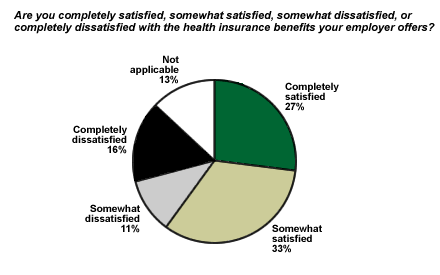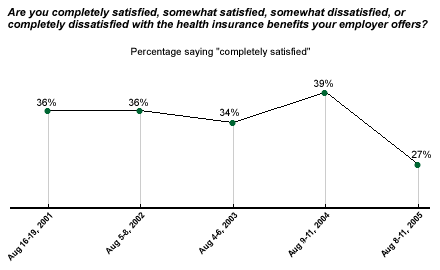Many of us have experienced the frustration of waiting on hold for a health insurance representative, only to be barraged by complicated explanations full of jargon and caveats. But despite all the red tape and the soaring cost of health insurance in the United States, a majority of U.S. workers remain satisfied with the health benefits their employers offer.

A ║┌┴¤═° Poll conducted Aug. 8-11, 2005*, shows 60% of Americans who are employed full or part time are satisfied with the health insurance benefits their employers offer, while 27% are not satisfied (13% of workers are coded as not applicable, presumably because they say their employer does not offer health benefits or because they are self-employed). However, the rising cost of insurance premiums and decreased coverage offered by employer-sponsored plans may be more likely to give respondents pause, because only 27% say they are completely satisfied, a significant drop from last year and the lowest percentage ║┌┴¤═° has measured dating back to 1989, when the question was first asked.

A survey respondent from South Carolina, a high-income manager for a distribution company, is completely satisfied with his company's benefits. "They cover my whole body: eyes, teeth, and all the internals. And at 31, I hope to have as little need as possible for them."
Rising Costs
Most U.S. workers who have health insurance receive it through employer-sponsored benefits from either their own or a family member's job. However, according to previous ║┌┴¤═° Polls of Americans who have private health insurance, the trend since 2001 shows that fewer employers are paying all healthcare premiums and more are sharing the costs with their employees. In 2003 and 2004, three-quarters of adults who pay all or part of their health premiums said the amount they pay for their and their families' health insurance has gone up.
Because of skyrocketing insurance premiums, business owners are confronted with difficult decisions about how to afford employee coverage. A representative from the American Benefits Council, a Washington, D.C.-based organization that advocates employer-sponsored benefit programs, offered the following insight: "Increasing cost rates are forcing companies to make changes to their plans. I would not be surprised, after multiple years of double-digit percentage increases in cost, if some companies were deciding to scale back what they pay for or the benefits they provide."
*Results are based on telephone interviews with 1,001 national adults, aged 18 and older, conducted Aug. 8-11, 2005. For results based on the total sample of national adults, one can say with 95% confidence that the margin of sampling error is ┬▒3 percentage points.
For results based on the sample of 564 adults employed full or part time, the maximum margin of sampling error is ┬▒5 percentage points.